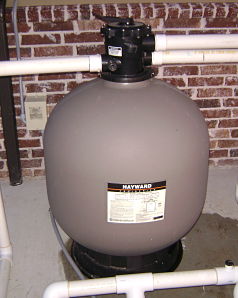Solving pool problems since 1985!
Filter Maintenance
Besides water chemistry and cleaning, the other routine pool maintenance job is servicing the filter. There are 3 basic filter types.
1. Sand Filter
Below is a photo of a Hayward Sand Filter with a top mounted multiport valve.

The sand filter is the most common filter type found in the Tulsa area, and is the favorite of all of our service techs. It is easily cleaned by backwashing which is reversing the flow of water through the filter so that the dirt and debris, which has become trapped on the bed of sand inside the filter, is rinsed out of the filter. The sand in a sand filter (#20 silica sand; 45 - 55 mm) is specially graded to trap particles in the 20 - 100 micron range. As a sand filter collects dirt, its efficiency increases, trapping more dirt.
"When should a sand filter be backwashed?"
The pressure gauge can tell you. After a good backwash, return the filter to its normal filtering mode, and while the pump is running, note the pressure reading. This is called the clean pressure measured in pounds per square inch (PSI). When this gauge reads 8-10 PSI greater than clean pressure, it's time to backwash.
Click here for backwash instructions.
"When should the old sand be replaced?"
As a rule of thumb, we say about every 5 years or so. However, we have seen pools that look great with older sand than that in the filter.
Sometimes we find pools that can't have a normal vacuum job done without having to be backwashed a couple of times. Sand filters that are acting like that definitely need a sand change.
Sometimes we see weekly vacuum jobs where normal size debris is passing right through the filter and blowing through the returns into the pool. We say the sand bed is "channeling" and sand change is a must in this case.
2. Diatomaceous Earth (D.E.) Filter
The D.E. filter is the most efficient type of pool filter on the market,but it is labor intensive. It can trap particles down to 3 - 5 microns; well below what the naked eye can see. As with sand filters, the pressure gauge indicates a need for backwashing when it reads 8 - 10 lbs. higher than its clean reading. After backwashing a D.E. filter, a new application of D.E. filter powder is added to the filter by pouring into the skimmer. An annual breakdown of the filter is necessary to thoroughly clean D.E. filter grids.
We don't recommend D.E. filters bacause they are a not user friendly compared to sand filters. Who wants to mess with storing and adding D.E. powder and taking apart the filter for cleaning when a sand filter is so much easier and effective? We can show you pools all over the Tulsa Metro area that look fantastic using sand filters.
"Why is there D.E. powder in my pool?"
You either have holes in the fabric of the grids, or a crack in the manifold that the grids attach to. It can also mean a broken air bleeder tube or assembly. Finally, D.E. in the pool can mean that the multiport or push-pull valve is allowing powder to bypass the filter.
Metro Pool Service charges $79.00/hr for D.E. filter repair, cleaning, and re-assembly.
3. Cartridge Filter
The cartridge filter element, much like the pleated air cleaner in your car, traps dirt and particles of 25 - 100 microns in size. The cartridge is removed from the tank and hosed thoroughly, top to bottom, with a high pressure hose to remove dirt when the pressure gauge rises 8 - 10 lbs. above its clean reading.
Some people take their cartridges to the local self serve car wash for cleaning. Each time the filter is cleaned, some of its filtering ability is reduced. The cartridge should be replaced every 2 - 5 yrs, depending on the work it was asked to do. If the filter was a bit undersized, and had some algae every year and lots of tree debris, etc. then it may last only 1 - 2 years.
Correctly sized cartridge filters can operate for up to 6 months between cleanings, but most of the ones we have seen need cleaned every few months. Our opinion is that these filters are, like D.E. filters, labor intensive compared to the very effective Sand Filter.
"How do I Backwash my Cartridge Filter?"
You don't. There is no backwash valve on a cartridge filter because today's pool filter cartridges aren't built for backwards flow. Instead, the pump is shut off, air bleeder opened, lid removed, cartridge removed, hosed thoroughly top to bottom, and replaced.
Metro Pool Service charges $79.00/hr for cartridge filter repair, cleaning, and re-assembly.
"How long should I run my filter each day?"
As much time as it takes to turn the whole pool water volume through the filter at least once every 24 hrs. In other words, if your pool is 30,000 gal. and your pump is pumping 50 gal/min. this is the calculation. 50 gal/min.x 60 min = 3000 gal/hr. 30,000 gal. divided by 3000 gal/hr.= 10 hrs. run time to filter the whole pool.
Many people run their systems 24 hours per day. The average (I would guess) would be about 12 hours. However, the right number of hours of pumprun time depends on your pool. Undersized filter? High pool Use? Large Debris Load? Heavy Sunlight? Any of these factors call for extra filtering. If you're too frugal with the electricity, your electric bill will look great, but your pool won't!
Remember: filtration + water chemistry + circulation = clear pool water
Our Advice....Get a Sand Filter!